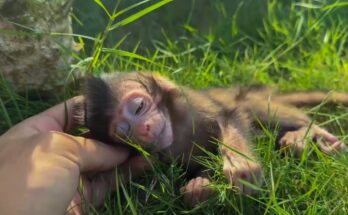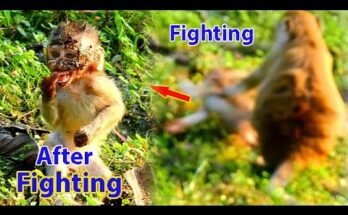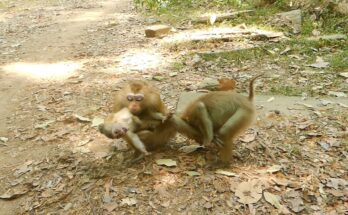Jungle Drama: Male Langur’s Aggression Amid Innocent Play
Deep within the dense and echoing canopies of an Indian forest, a compelling scene of primal instinct and social tension unfolds—one that brings the raw truths of wildlife behavior into stark focus. At first glance, the scene is idyllic: a group of langurs—those agile, long-limbed primates with expressive eyes and silvery coats—leap from branch to branch, the younger ones caught in a flurry of innocent play. Their chirps and rustling leaves create a rhythm that resonates with the natural harmony of the jungle.
But this calm is suddenly fractured. A dominant adult male langur, easily distinguishable by his larger size and intense gaze, storms into the group with forceful energy. His arrival is not met with warmth but with tension and retreat. The younger langurs scatter, and the females swiftly pull their infants close. The air grows heavy with unease as the male’s aggression becomes apparent.
This is not an isolated act of violence, but rather a glimpse into the intricate and sometimes brutal dynamics of langur society. In many species of primates, including the Hanuman langur, social structure is matriarchal in daily routines but dictated by powerful, dominant males who fight to control groups of females—known as harems. When a new male takes over a troop, he may exhibit aggressive behaviors to assert dominance, including targeting the infants sired by his predecessor. This grim phenomenon, known as infanticide, is nature’s harsh strategy: by eliminating offspring that are not his own, the male triggers the females to return to fertility more quickly, ensuring the propagation of his genes.
In the observed drama, the male’s aggressive behavior is likely driven by such evolutionary imperatives. What appears, to human eyes, as a violent interruption of joyful play is in fact a calculated act rooted in survival and reproduction. The innocence of the young langurs, engaged moments earlier in carefree frolicking, sharply contrasts with the stark consequences of adult power dynamics.
For wildlife observers and conservationists, moments like this are difficult to watch, but essential to understand. They illuminate the complexity of animal societies—where behaviors are not purely violent or benign, but deeply intertwined with ecological pressures, mating strategies, and genetic legacy. Such events serve as powerful reminders that the jungle, for all its beauty and wonder, operates on laws quite different from our human moral compass.
“Jungle Drama: Male Langur’s Aggression Amid Innocent Play” is more than a snapshot of conflict—it’s a window into the emotional and behavioral landscape of a species that mirrors aspects of our own: social bonds, parental care, competition, and survival. The drama may be fleeting in time, but its implications ripple through the troop’s future, shaping the next generation in the most primal of ways.


